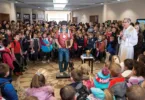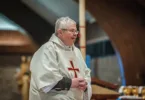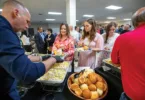by Joe Bollig
By now, most Catholics in the archdiocese have heard something about the new Roman Missal, with changes in how we worship at the Mass, coming our way in late 2011. But that’s not the only big change coming down the pike this year. History will be made with the pioneering class of permanent deacons for the archdiocese will be ordained on April 9 at St. Michael the Archangel Parish in Leawood.
Although the concept of permanent deacons may seem new or even odd to a lot of Catholics in northeast Kansas, other parts of the United States and the world have had permanent deacons for more than 40 years.
Indeed, deacons aren’t new. There have been deacons in the church since apostolic times, although in various forms. For example, all priests are first ordained deacons — albeit transitional ones — before they are ordained to the priesthood.
But the vocation of deacon is not just a stop on the road to priesthood — the diaconate is a vocation in its own right. At the Second Vatican Council, in fact, it was clearly identified as one of the three orders of Catholic clerics — the others being priest and bishop.
Often, deacons have jobs and families like regular laypeople, but not al- ways.
To get a better understanding of who deacons are and what they do, the archdiocese sponsored a workshop for priests of the archdiocese on Jan. 13 at Savior Pastoral Center in Kansas City, Kan.
Deacon William T. Ditewig, who presented the workshop, was ordained a permanent deacon in 1990 in Washington, D.C. He served for a number of years as executive director of the Secretariat for the Diaconate for the U.S. Conference of Catholic Bishops, and is now a professor of theology and director of graduate programs in theology at St. Leo University near Tampa, Fla.
It’s about service
There are several passages in Scripture that tie caring for those in need with living according to the covenants God establishes with humans, said Deacon Ditewig.
“[One is] the whole notion of the ‘suffering servant’ in [the Book of] Isaiah, and later Christ the suffering servant,” said Ditewig. “Why is this important? Because all of the literature from the Second Vatican Council and beyond talks about deacons and their being icons of Christ the servant.”
Indeed, that is how the deacons of the early church were utilized — as servants. They were the ones whose responsibility it was to tend to the needs of the widows and the orphans. One great symbol we have of the ‘suffering servant’ is Jesus washing the feet of his disciples at the Last Supper. This was a lesson not just about doing menial tasks with humility but a pouring out of oneself.
The early church saw a great diversity in both types of ministry and types of ministers. As the roles of deacons, priests, and bishops evolved and became more distinct, the deacons came to be more closely associated with service to the bishop.
“There was a great diversity of function for deacons, and [it] included functions of administration, judicial functions, and liturgical,” said Deacon Ditewig.
Deacons did “social justice” work — administering charity, for example — while priests fulfilled the sacramental needs of the faithful. For many years, priest and deacons were seen as the “two arms” of the bishop, said Deacon Ditewig.
Return of a golden age
The golden age of deacons ended around 325 A.D. In later centuries a change in canon law decreed that all functions of the deacon were considered “extraordinary.”
That meant that the diaconate was clearly subordinate to the presbyter (priest) and merely transitional. In other words, except for very rare cases, no one became a deacon without the intention of going on to becoming a priest. But the idea of a permanent diaconate was not entirely lost.
There were discussions during the Council of Trent (1545 – 1563), for ex- ample, of renewing the permanent diaconate with all its ancient function and status. The Protestant Reformation, however, kept successive popes from undertaking the renewal.
It took Pope Paul VI in 1967, in fact, to finally initiate the changes in canon law, implementing the decrees of the Second Vatican Council, for the renewal of the permanent diaconate to take place.
Some important things, however, took place before the council, which sowed the seeds for the its decisions.
The German bishops had been talking about the renewal of the diaconate since the 1840s. Late in the 19th century, German bishops established organizations for charitable works, called the Caritas, which carried out the very sort of work done by deacons in the early church.
When the Nazis came to power in the 1930s, the church was one of the party’s early targets. Eventually, thousands of Catholic priests (as well as Protestant ministers) would be rounded up and sent to concentration camps for “re-education.”
Ironically, the “Priestblock” at Dachau concentration camp quickly became an incubator for renewal as priests from throughout Europe were brought to- gether by their imprisonment. This, and the experience of World War II, shaped the worldview of the bishops who at- tended the Second Vatican Council.
In 1947, Pope Pius XII described the matter and form of the three orders of clergy — deacon, priest and bishop — in the apostolic constitution “Sacramentum Ordinis” (“On the Sacrament of Order”). And during the 1957 Eucharistic Congress, he spoke favorably about the renewal of the diaconate.
Also, while the priest-survivors of Dachau wrote of their experiences, a German layman named Hannes Kramer approached his bishop in 1950 and told him he felt called to be a deacon. The bishop said the time wasn’t right for this, but he suggested that Kramer continue to explore this vocation. Kramer and other laymen formed “deacon circles” and began to study, pray, and do charitable works in areas of great social need. By the Second Vatican Council, there were approximately three dozen deacon circles in Germany and France.
“As the council began in 1962, the notion of charitable service — diakonia (in Greek) — that is sacramentally linked to word and worship, are seen as three essential constitutive elements of the church,” said Deacon Ditewig.
The council saw the renewal of the diaconate as only one element of a larg- er program of reform in the church, he said.
Many difficult issues about the permanent diaconate were thrashed out at the council, but many questions remained, particularly practical ones. On June 18, 1967, Pope Paul VI issued the motu proprio “Sacrum Diaconatus Ordinem,” the general norms for restoring the permanent diaconate. Shortly after, bishops in various countries began to ask Rome for permission to ordain permanent deacons. The first men — who were members of the deacon circles — were ordained in Germany in 1968. Many other countries followed suit, including the United States in 1969.
Deacons here and now
The Archdiocese of Kansas City in Kansas can benefit from the experience of other dioceses in terms of diaconal ministry, said Deacon Ditewig.
Originally, the council fathers thought that deacons would be relatively young men, but in the United States the average age of deacons is rising. Many of the deacons are well-educated and employed in secular jobs, although a good percentage of them are at the end of their secular work careers. There are about 17,000 deacons in the United States — about half the world’s total.
The role of the deacon is to be a witness — to transform the world by representing Christ in those areas of greatest need, said Deacon Ditewig.
In his comments at the end of the day, Archbishop Joseph F. Naumann said he looked forward to deacons ministering in the archdiocese.
“One of the gifts that the permanent diaconate will be to give us is additional, well-formed ordained ministers for service of God’s people,” he said.
“To have these ministers bring Christ in a very unique way . . . will be a great gift,” he added. “I think one of the things I look forward to is [seeing] how our deacons will help us to see how we can be more of a servant church to those on the margins, those who are forgotten.”






